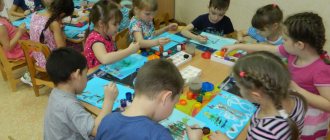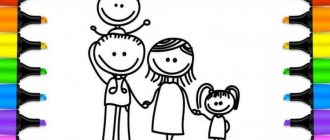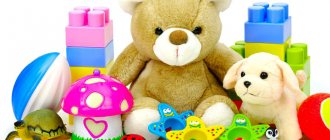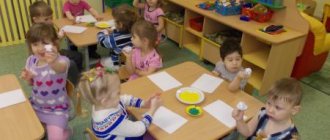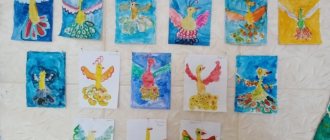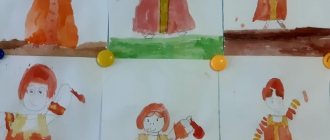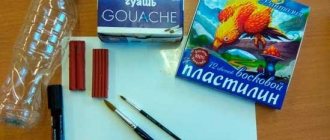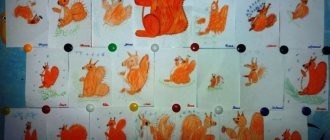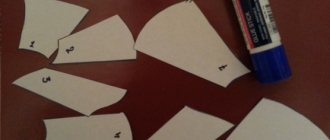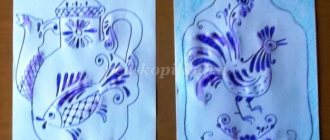MAGAZINE Preschooler.RF
Summary of the drawing lesson “Funny nesting dolls” preparatory groupSpeech group teacher Nekhorosheva N.A.
Goal: To acquaint children with the history of folk toys, its appearance, appearance, and the features of painting matryoshka dolls. To develop the creative imagination of children, their independence in coming up with a design for a sundress for a nesting doll. Practice drawing various floral designs.
Continue to raise children in Russian folk traditions, deepen their knowledge of folk art. Develop creative storytelling skills, writing a story about a toy; strengthen coherent speech skills.
Progress of the lesson:
Educator: Guys, today I invite you to an exhibition. And guess what you will see there, just listen to the riddle to the end, it will tell you a lot
will tell.
Like a turnip, it is steep-sided, And under a scarlet scarf Looks at us cheerfully, smartly, widely With a pair of black currants - an eye,
A scarlet silk scarf, a bright sundress with a flower, a hand resting on the wooden sides, and inside there are secrets:
Maybe three, maybe six. Our Russian (MATRYOSHKA) got a little flushed
Educator: That's right, one of the most favorite toys among the people, children had nesting dolls. Guys, do you want to know where this interesting thing came to us from?
toy?
Educator: Then listen. It seems that the nesting doll came to us from the world of legends and fairy tales, from ancient times. In fact, she is only a little over 100 years old. There are many speculations about how and when she was born. Here is one of them. About 100 years ago, merchants brought to Russia from distant Japan a small toy - a doll, inside of which were several more figures nested one inside the other. Both adults and children liked this doll. And after a while, we had toy girls in Russia who nested one inside the other. In shape they resembled a Japanese toy, but they were already dressed in Russian costume: a sundress, aprons, and scarves. These dolls were called Matryona, affectionately called Matryoshka.
Game "Call me affectionately"
So your names are beautiful when they sound affectionate.
Educator: Let's return to the story about the nesting doll. Russians loved this toy.
They began to sharpen it from a wooden block on lathes. The matryoshka figurine is separated into two parts, and there is another figurine in it.
Matryoshka dolls can be large, multi-seater, which can accommodate up to 24 sisters, and the simplest - only 3 dolls. At the beginning, the smallest, one-piece figure is made. Then the figurine is sanded and painted, sometimes varnished. They are still being made: near Moscow, in Sergiev Posad, and near Novgorod - in the village of Semenov, and not far from the city of Murom - in Polkhov-Maidan. Each master, nesting dolls have their own face, their own outfit and their own character. But each one is “dressed” in a peasant costume: a painted sundress, a scarf, an apron.
Educator: Well, did you like the toys? I suggest playing with them.
Game for developing fine motor skills “Eight nesting dolls” , with reading a poem.
Eight wooden dolls, round-cheeked and ruddy, live on our table in multi-colored sundresses, They call them all matryoshka dolls!
The first doll is fat, but inside it is empty. It splits into two halves, There lives another doll in it in the middle. Open this doll - there will be a third in the second!
Unscrew the tight, ground-in half - And you will be able to find the fourth doll. Take it out and see who is hiding inside it. The fifth one is hiding in it, a pot-bellied doll
And inside it is empty, there is a sixth doll in it, And in the sixth there is a seventh, and the seventh is an eighth. This doll is the smallest of all, a little larger than a nut. Here are the sisters standing in a row - dolls.
- How many of you? - we’ll ask them
The dolls will answer M - Eight!
Educator: Then sit down at the tables and try to paint the nesting dolls yourself
(paper silhouettes of nesting dolls) as craftsmen - artists. First circle
silhouette of a nesting doll and all the details of clothing in black pencil, and then
Use watercolor paints to make the nesting dolls colorful and bright. I
I suggest you guys get creative and paint your costume
nesting dolls using Khokhloma, Gzhel, Dymkovo painting.
Phys. just a minute.
The girlfriends are different in height, but they look alike. They all live in each other, And only one toy.
Educator: After finishing work, invite the children to tell where their nesting dolls came from, what are the features of their costume, and why the costume is the way it is.
Guys, for your beautiful works, there is a treat in the largest nesting doll at our exhibition. Let's find this nesting doll, treat the guests and don't forget about ourselves.
Our lesson is over.
| Next > |
How to draw a toy with a pencil step by step
Step one. First, let's create a blank form that looks like a small bottle. And let's put a cute bear there. Step two. Using round shapes we create all parts of the bear’s body and add a bow. Step three. We outline everything a little tighter, removing unnecessary lines. For decoration, add a butterfly to the neck of the toy. Shade out the nose and eyes. Step four. Let's delete the auxiliary lines drawn earlier. Step five. Let's add shading throughout the body to make it more realistic. Don't forget to show your drawings of toys later. You can attach them below in the comments, and also write to me what other lessons I can prepare for you. You can do this on the orders page. It will also be useful for you to read.
I propose a summary of direct educational activities for children of the older group of 5-6 years old on the topic: “My favorite toy.” This material will be useful to teachers of the senior group. This is a summary of a comprehensive lesson in visual arts, aimed at developing emotional responsiveness and conveying your mood with paints.
Program content: Introduce children to Bogorodsk crafts. Learn to see the dynamics of toys, the expressiveness of images. To cultivate interest and respect for the painstaking work of Bogorodsk woodcarvers.
Materials: Screen, behind the screen there is a table on which Bogorodsk toys are located, depicting peasant labor, genre scenes, images of animals and birds: tea drinking, hammersmiths, sawmills, spinners, a peasant playing the pipe, a bear with a balalaika, a dancing bear, pecking chickens, etc.
Tools:
Knife, straight and round chisels, linden block, blanks (wooden blocks). Everything is made of wood.
Two chairs, crowns for the princess and prince.
Progress of the lesson
Teacher's story:
-Children, do you like fairy tales? Do you know how to tell them yourself?
-Now we will do this together with you.
He places the crown of the princess and the prince on the heads of the two children and places them on path chairs.
-You will help revive fairy tale characters with a “magic wand”.
“A long time ago, in a certain princess-state, in the village of Bogorodskoye, there lived an old man and an old woman. They lived without bothering - they drank tea (showing the Bogorodsk toy “Tea Party”, which is brought to life by a magic wand, showing the toy in motion). Well, they lived richly, there were a lot of livestock in the yard (pranks of animal toys, pecking chickens, etc.)
Draws attention to the fine carving, which perfectly conveys the plumage of birds, animal hair, invites you to touch it with your hand, feel the warmth of the wood, imitate the movements of animals and birds. The old man and the old woman had many assistants; they helped run a large household (show of toys: “Blacksmiths-Hammerers”, “Bear and Peasant”).
After work we had a fun time: we sang, danced, and did round dances (display of toys: “Bear Dancer”, “Buffoons”, “Bear on a Bicycle”, “Peasant Playing the Pipe”).
An old man and an old woman lived happily ever after in the village of Bogorodskoye.
Did you like the fairy tale? What about our Bogorodsk toys?
These toys were made in the village of Bogorodskoye, which is located near the city of Sergiev Posad.
The figures of these toys are made of soft wood: linden, aspen, alder.
To make it softer, it is steamed in an oven and then dried.
Bogorodsk figurines are not painted, but retain the natural color of the wood.
Carving consists of several stages: first the master outlines the main forms of the future sculpture, then! processes the silhouette and all parts with wide semicircular chisels, and completes the decorative finishing of the surface with the help of small chisels with rhythmic stripes.
This painting conveys the fur of animals and the plumage of birds.
-Children, do you think it’s easy to cut out these toys?
-Difficult!
-Therefore, they need to be treated with care, caution, and love, as the tree asks for affection.
Shows how to hold toys, how to set them in motion, invites you to listen to the beautiful sound of gentle, warm linden wood, shows how toys are set in motion.
He invites the children whose toy is moved by the ball to go out to the prince and princess, the children who have push-button toys come up next. Then twitch toys.
Children stand up with toys in a round dance, walk in a circle, dancing to the cheerful music of wooden toys.
-Evening is coming. It's time to drive the cattle into the yard, the chickens into the chicken coop, and the workers to rest. The toys return to the fairy tale kingdom, the fairy tale is over.
On the topic: methodological developments, presentations and notes
This development of an educational educational activity for visual activities (drawing) “My beloved home” is intended for children of senior preschool age.
Summary of educational activities for visual activities “I will give my beloved mother a gift” (middle group).
Children raised to work from an early age are distinguished by independence, organization, activity, neatness, and the ability to take care of themselves. To successfully solve problems in labor education of preschools.
GCD for the preparatory group.
SYNOPSIS Lessons on visual arts in the middle group topic: “My favorite fish” (using non-traditional drawing techniques) Non-traditional techniques: wax.
Source
